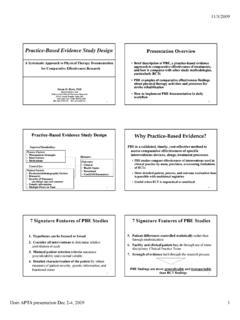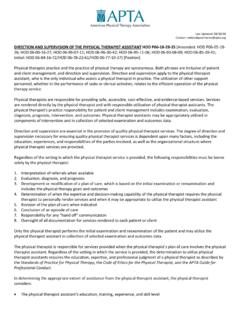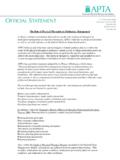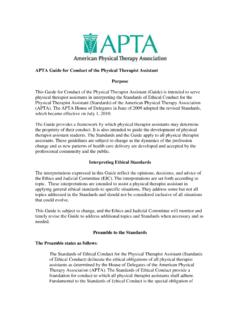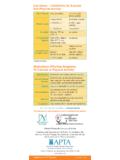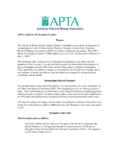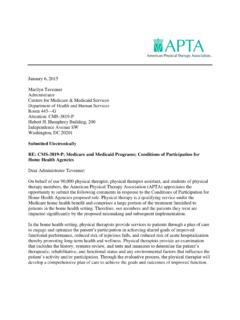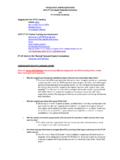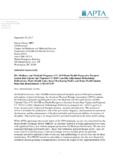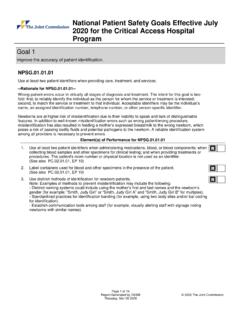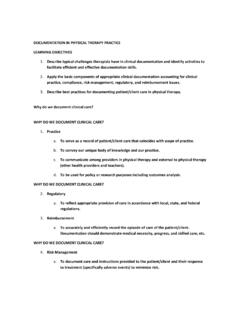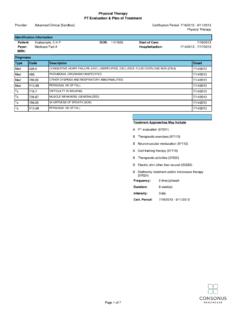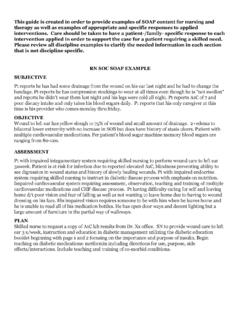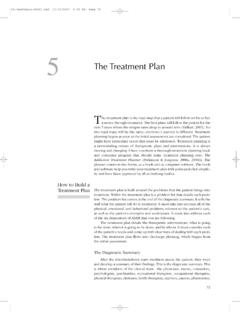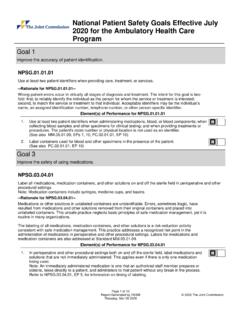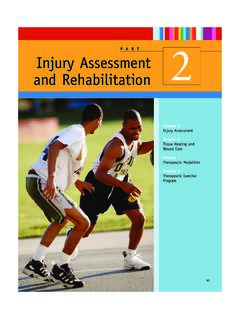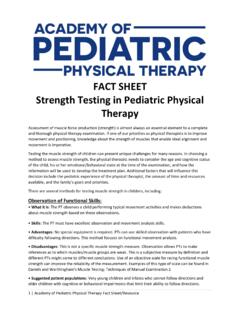Transcription of GUIDELINES: PHYSICAL THERAPY DOCUMENTATION OF …
1 Last Updated: 05/19/14 Contact: guidelines : PHYSICAL THERAPY DOCUMENTATION OF PATIENT/CLIENT MANAGEMENT BOD G03-05-16-41 [Amended BOD 02-02-16-20; BOD 11-01-06-10; BOD 03-01-16-51; BOD 03-00-22-54; BOD 03-99-14-41; BOD 11-98-19-69; BOD 03-97-27-69; BOD 03-95-23-61; BOD 11-94-33-107; BOD 06-93-09-13; Initial BOD 03-93-21-55] [Guideline] PREAMBLE The American PHYSICAL THERAPY Association (APTA) is committed to meeting the PHYSICAL THERAPY needs of society, to meeting the needs and interests of its members, and to developing and improving the art and science of PHYSICAL THERAPY , including practice, education and research.
2 To help meet these responsibilities, APTA s Board of Directors has approved the following guidelines for PHYSICAL THERAPY DOCUMENTATION . It is recognized that these guidelines do not reflect all of the unique DOCUMENTATION requirements associated with the many specialty areas within the PHYSICAL THERAPY profession. Applicable for both hand written and electronic DOCUMENTATION systems, these guidelines are intended to be used as a foundation for the development of more specific DOCUMENTATION guidelines in clinical areas, while at the same time providing guidance for the PHYSICAL THERAPY profession across all practice settings.
3 DOCUMENTATION may also need to address additional regulatory or payer requirements. Finally, be aware that these guidelines are intended to address DOCUMENTATION of patient/client management, not to describe the provision of PHYSICAL THERAPY services. Other APTA documents, including APTA Standards of Practice for PHYSICAL THERAPY , Code of Ethics and Guide for Professional Conduct, and the Guide to PHYSICAL Therapist Practice, address provision of PHYSICAL THERAPY services and patient/client management. APTA POSITION ON DOCUMENTATION DOCUMENTATION Authority For PHYSICAL THERAPY Services PHYSICAL THERAPY examination, evaluation, diagnosis, prognosis, and plan of care (including interventions) shall be documented, dated, and authenticated by the PHYSICAL therapist who performs the service.
4 Interventions provided by the PHYSICAL therapist or selected interventions provided by the PHYSICAL therapist assistant under the direction and supervision of the PHYSICAL therapist are documented, dated, and authenticated by the PHYSICAL therapist or, when permissible by law, the PHYSICAL therapist assistant. Other notations or flow charts are considered a component of the documented record but do not meet the requirements of DOCUMENTATION in or of themselves. Students in PHYSICAL therapist or PHYSICAL therapist assistant programs may document when the record is additionally authenticated by the PHYSICAL therapist or, when permissible by law, DOCUMENTATION by PHYSICAL therapist assistant students may be authenticated by a PHYSICAL therapist assistant.
5 OPERATIONAL DEFINITIONS guidelines APTA defines a "guideline" as a statement of advice. Authentication The process used to verify that an entry is complete, accurate and final. Indications of authentication can include original written signatures and computer "signatures" on secured electronic record systems only. The following describes the main DOCUMENTATION elements of patient/client management: 1) initial examination/evaluation, 2) visit/encounter, 3) reexamination, and 4) discharge or discontinuation summary.
6 Initial Examination/Evaluation DOCUMENTATION of the initial encounter is typically called the initial examination, initial evaluation, or initial examination/evaluation. Completion of the initial examination/ evaluation is typically completed in one visit, but may occur over more than one visit. DOCUMENTATION elements for the initial examination/evaluation include the following: Examination: Includes data obtained from the history, systems review, and tests and measures. Evaluation: Evaluation is a thought process that may not include formal DOCUMENTATION .
7 It may include DOCUMENTATION of the assessment of the data collected in the examination and identification of problems pertinent to patient/client management. Diagnosis: Indicates level of impairment, activity limitation and participation restriction determined by the PHYSICAL therapist. May be indicated by selecting one or more preferred practice patterns from the Guide to PHYSICAL Therapist Practice. Prognosis: Provides DOCUMENTATION of the predicted level of improvement that might be attained through intervention and the amount of time required to reach that level.
8 Prognosis is typically not a separate DOCUMENTATION elements, but the components are included as part of the plan of care. Plan of care: Typically stated in general terms, includes goals, interventions planned, proposed frequency and duration, and discharge plans. Visit/Encounter DOCUMENTATION of a visit or encounter, often called a progress note or daily note, documents sequential implementation of the plan of care established by the PHYSICAL therapist, including changes in patient/client status and variations and progressions of specific interventions used.
9 Also may include specific plans for the next visit or visits. Reexamination DOCUMENTATION of reexamination includes data from repeated or new examination elements and is provided to evaluate progress and to modify or redirect intervention. Discharge or Discontinuation Summary DOCUMENTATION is required following conclusion of the current episode in the PHYSICAL THERAPY intervention sequence, to summarize progression toward goals and discharge plans. GENERAL guidelines DOCUMENTATION is required for every visit/encounter.
10 All DOCUMENTATION must comply with the applicable jurisdictional/regulatory requirements. All handwritten entries shall be made in ink and will include original signatures. Electronic entries are made with appropriate security and confidentiality provisions. Charting errors should be corrected by drawing a single line through the error and initialing and dating the chart or through the appropriate mechanism for electronic DOCUMENTATION that clearly indicates that a change was made without deletion of the original record.
